roof rack NISSAN QASHQAI 2019 Owner´s Manual
[x] Cancel search | Manufacturer: NISSAN, Model Year: 2019, Model line: QASHQAI, Model: NISSAN QASHQAI 2019Pages: 500, PDF Size: 2.38 MB
Page 12 of 500
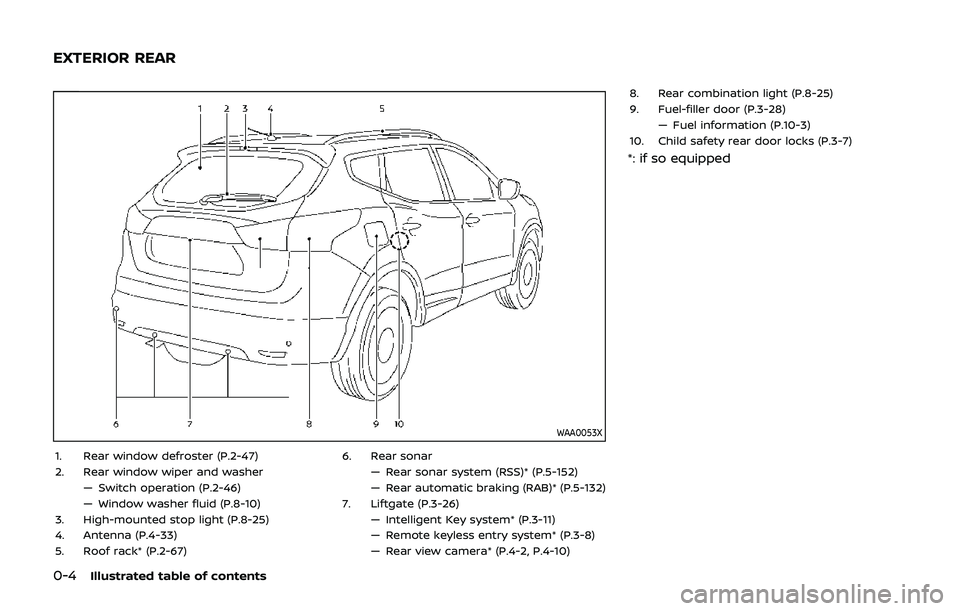
0-4Illustrated table of contents
WAA0053X
1. Rear window defroster (P.2-47)
2. Rear window wiper and washer— Switch operation (P.2-46)
— Window washer fluid (P.8-10)
3. High-mounted stop light (P.8-25)
4. Antenna (P.4-33)
5. Roof rack* (P.2-67) 6. Rear sonar
— Rear sonar system (RSS)* (P.5-152)
— Rear automatic braking (RAB)* (P.5-132)
7. Liftgate (P.3-26) — Intelligent Key system* (P.3-11)
— Remote keyless entry system* (P.3-8)
— Rear view camera* (P.4-2, P.4-10) 8. Rear combination light (P.8-25)
9. Fuel-filler door (P.3-28)
— Fuel information (P.10-3)
10. Child safety rear door locks (P.3-7)
*: if so equipped
EXTERIOR REAR
Page 75 of 500
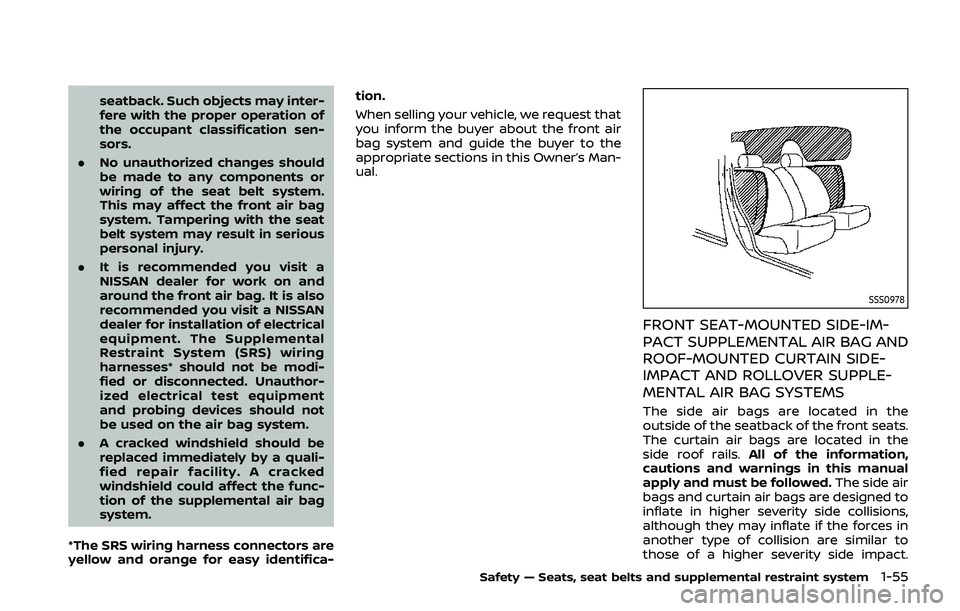
seatback. Such objects may inter-
fere with the proper operation of
the occupant classification sen-
sors.
. No unauthorized changes should
be made to any components or
wiring of the seat belt system.
This may affect the front air bag
system. Tampering with the seat
belt system may result in serious
personal injury.
. It is recommended you visit a
NISSAN dealer for work on and
around the front air bag. It is also
recommended you visit a NISSAN
dealer for installation of electrical
equipment. The Supplemental
Restraint System (SRS) wiring
harnesses* should not be modi-
fied or disconnected. Unauthor-
ized electrical test equipment
and probing devices should not
be used on the air bag system.
. A cracked windshield should be
replaced immediately by a quali-
fied repair facility. A cracked
windshield could affect the func-
tion of the supplemental air bag
system.
*The SRS wiring harness connectors are
yellow and orange for easy identifica- tion.
When selling your vehicle, we request that
you inform the buyer about the front air
bag system and guide the buyer to the
appropriate sections in this Owner’s Man-
ual.
SSS0978
FRONT SEAT-MOUNTED SIDE-IM-
PACT SUPPLEMENTAL AIR BAG AND
ROOF-MOUNTED CURTAIN SIDE-
IMPACT AND ROLLOVER SUPPLE-
MENTAL AIR BAG SYSTEMS
The side air bags are located in the
outside of the seatback of the front seats.
The curtain air bags are located in the
side roof rails. All of the information,
cautions and warnings in this manual
apply and must be followed. The side air
bags and curtain air bags are designed to
inflate in higher severity side collisions,
although they may inflate if the forces in
another type of collision are similar to
those of a higher severity side impact.
Safety — Seats, seat belts and supplemental restraint system1-55
Page 82 of 500
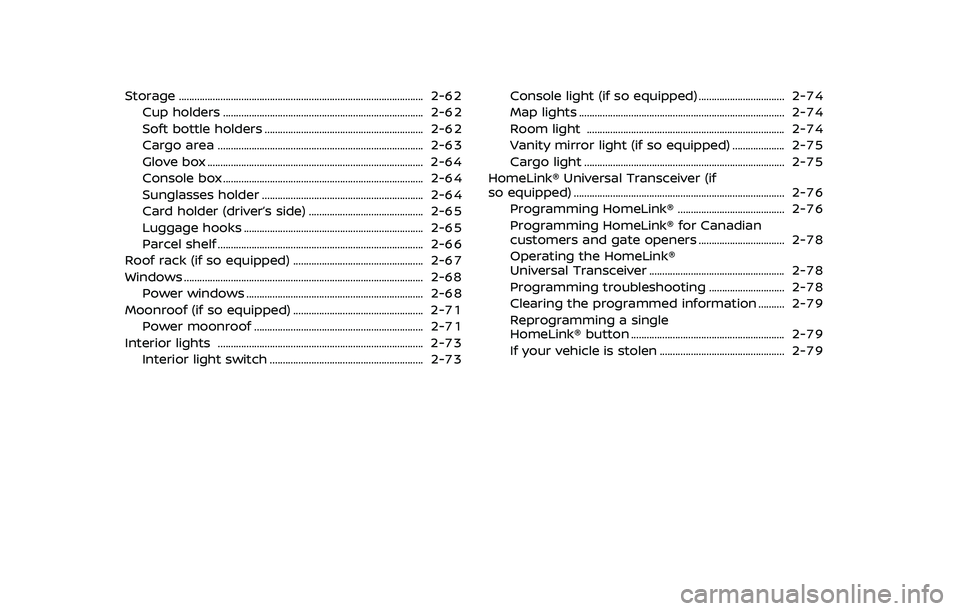
Storage ........................................................................\
...................... 2-62Cup holders ........................................................................\
..... 2-62
Soft bottle holders ............................................................. 2-62
Cargo area ........................................................................\
....... 2-63
Glove box ........................................................................\
........... 2-64
Console box ........................................................................\
..... 2-64
Sunglasses holder .............................................................. 2-64
Card holder (driver’s side) ............................................ 2-65
Luggage hooks ..................................................................... 2-65
Parcel shelf ........................................................................\
....... 2-66
Roof rack (if so equipped) .................................................. 2-67
Windows ........................................................................\
.................... 2-68 Power windows .................................................................... 2-68
Moonroof (if so equipped) .................................................. 2-71
Power moonroof ................................................................. 2-71
Interior lights ........................................................................\
....... 2-73 Interior light switch ........................................................... 2-73 Console light (if so equipped) ................................. 2-74
Map lights ........................................................................\
....... 2-74
Room light ........................................................................\
.... 2-74
Vanity mirror light (if so equipped) .................... 2-75
Cargo light ........................................................................\
..... 2-75
HomeLink® Universal Transceiver (if
so equipped) ........................................................................\
......... 2-76 Programming HomeLink® ......................................... 2-76
Programming HomeLink® for Canadian
customers and gate openers ................................. 2-78
Operating the HomeLink®
Universal Transceiver .................................................... 2-78
Programming troubleshooting ............................. 2-78
Clearing the programmed information .......... 2-79
Reprogramming a single
HomeLink® button ........................................................... 2-79
If your vehicle is stolen ................................................ 2-79
Page 147 of 500
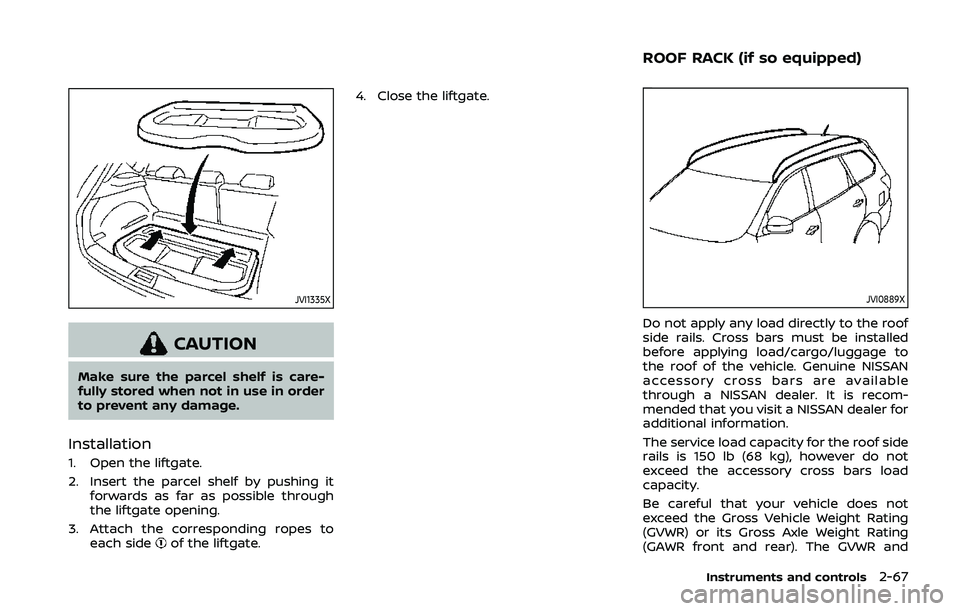
JVI1335X
CAUTION
Make sure the parcel shelf is care-
fully stored when not in use in order
to prevent any damage.
Installation
1. Open the liftgate.
2. Insert the parcel shelf by pushing itforwards as far as possible through
the liftgate opening.
3. Attach the corresponding ropes to each side
of the liftgate. 4. Close the liftgate.
JVI0889X
Do not apply any load directly to the roof
side rails. Cross bars must be installed
before applying load/cargo/luggage to
the roof of the vehicle. Genuine NISSAN
accessory cross bars are available
through a NISSAN dealer. It is recom-
mended that you visit a NISSAN dealer for
additional information.
The service load capacity for the roof side
rails is 150 lb (68 kg), however do not
exceed the accessory cross bars load
capacity.
Be careful that your vehicle does not
exceed the Gross Vehicle Weight Rating
(GVWR) or its Gross Axle Weight Rating
(GAWR front and rear). The GVWR and
Instruments and controls2-67
ROOF RACK (if so equipped)
Page 148 of 500
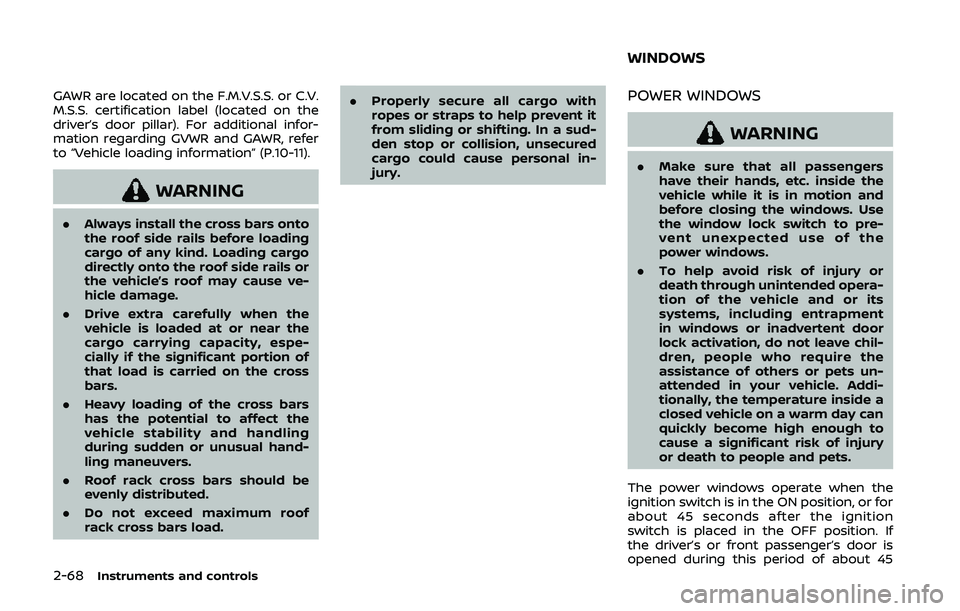
2-68Instruments and controls
GAWR are located on the F.M.V.S.S. or C.V.
M.S.S. certification label (located on the
driver’s door pillar). For additional infor-
mation regarding GVWR and GAWR, refer
to “Vehicle loading information” (P.10-11).
WARNING
.Always install the cross bars onto
the roof side rails before loading
cargo of any kind. Loading cargo
directly onto the roof side rails or
the vehicle’s roof may cause ve-
hicle damage.
. Drive extra carefully when the
vehicle is loaded at or near the
cargo carrying capacity, espe-
cially if the significant portion of
that load is carried on the cross
bars.
. Heavy loading of the cross bars
has the potential to affect the
vehicle stability and handling
during sudden or unusual hand-
ling maneuvers.
. Roof rack cross bars should be
evenly distributed.
. Do not exceed maximum roof
rack cross bars load. .
Properly secure all cargo with
ropes or straps to help prevent it
from sliding or shifting. In a sud-
den stop or collision, unsecured
cargo could cause personal in-
jury.
POWER WINDOWS
WARNING
.Make sure that all passengers
have their hands, etc. inside the
vehicle while it is in motion and
before closing the windows. Use
the window lock switch to pre-
vent unexpected use of the
power windows.
. To help avoid risk of injury or
death through unintended opera-
tion of the vehicle and or its
systems, including entrapment
in windows or inadvertent door
lock activation, do not leave chil-
dren, people who require the
assistance of others or pets un-
attended in your vehicle. Addi-
tionally, the temperature inside a
closed vehicle on a warm day can
quickly become high enough to
cause a significant risk of injury
or death to people and pets.
The power windows operate when the
ignition switch is in the ON position, or for
about 45 seconds after the ignition
switch is placed in the OFF position. If
the driver’s or front passenger’s door is
opened during this period of about 45
WINDOWS
Page 239 of 500
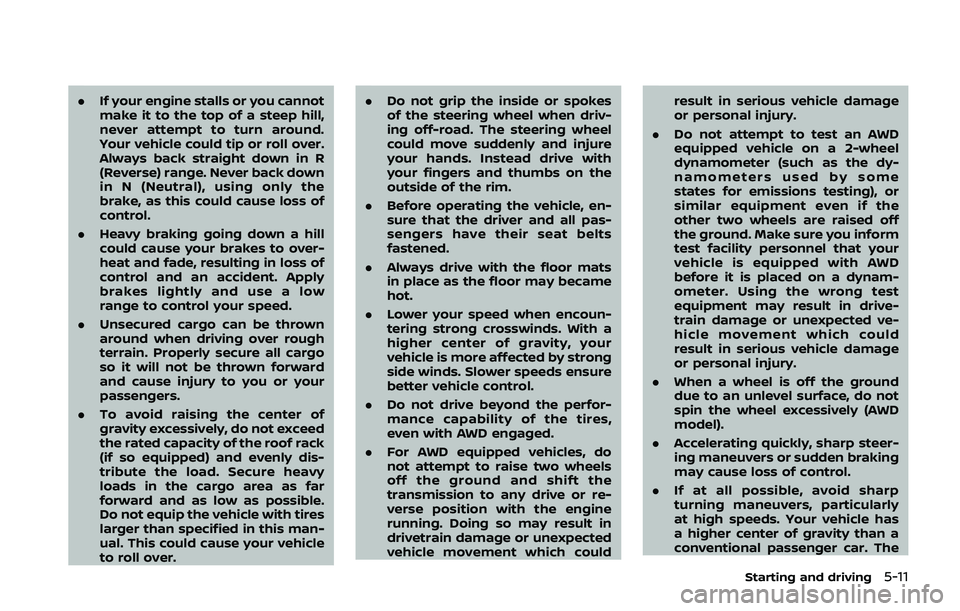
.If your engine stalls or you cannot
make it to the top of a steep hill,
never attempt to turn around.
Your vehicle could tip or roll over.
Always back straight down in R
(Reverse) range. Never back down
in N (Neutral), using only the
brake, as this could cause loss of
control.
. Heavy braking going down a hill
could cause your brakes to over-
heat and fade, resulting in loss of
control and an accident. Apply
brakes lightly and use a low
range to control your speed.
. Unsecured cargo can be thrown
around when driving over rough
terrain. Properly secure all cargo
so it will not be thrown forward
and cause injury to you or your
passengers.
. To avoid raising the center of
gravity excessively, do not exceed
the rated capacity of the roof rack
(if so equipped) and evenly dis-
tribute the load. Secure heavy
loads in the cargo area as far
forward and as low as possible.
Do not equip the vehicle with tires
larger than specified in this man-
ual. This could cause your vehicle
to roll over. .
Do not grip the inside or spokes
of the steering wheel when driv-
ing off-road. The steering wheel
could move suddenly and injure
your hands. Instead drive with
your fingers and thumbs on the
outside of the rim.
. Before operating the vehicle, en-
sure that the driver and all pas-
sengers have their seat belts
fastened.
. Always drive with the floor mats
in place as the floor may became
hot.
. Lower your speed when encoun-
tering strong crosswinds. With a
higher center of gravity, your
vehicle is more affected by strong
side winds. Slower speeds ensure
better vehicle control.
. Do not drive beyond the perfor-
mance capability of the tires,
even with AWD engaged.
. For AWD equipped vehicles, do
not attempt to raise two wheels
off the ground and shift the
transmission to any drive or re-
verse position with the engine
running. Doing so may result in
drivetrain damage or unexpected
vehicle movement which could result in serious vehicle damage
or personal injury.
. Do not attempt to test an AWD
equipped vehicle on a 2-wheel
dynamometer (such as the dy-
namometers used by some
states for emissions testing), or
similar equipment even if the
other two wheels are raised off
the ground. Make sure you inform
test facility personnel that your
vehicle is equipped with AWD
before it is placed on a dynam-
ometer. Using the wrong test
equipment may result in drive-
train damage or unexpected ve-
hicle movement which could
result in serious vehicle damage
or personal injury.
. When a wheel is off the ground
due to an unlevel surface, do not
spin the wheel excessively (AWD
model).
. Accelerating quickly, sharp steer-
ing maneuvers or sudden braking
may cause loss of control.
. If at all possible, avoid sharp
turning maneuvers, particularly
at high speeds. Your vehicle has
a higher center of gravity than a
conventional passenger car. The
Starting and driving5-11
Page 478 of 500
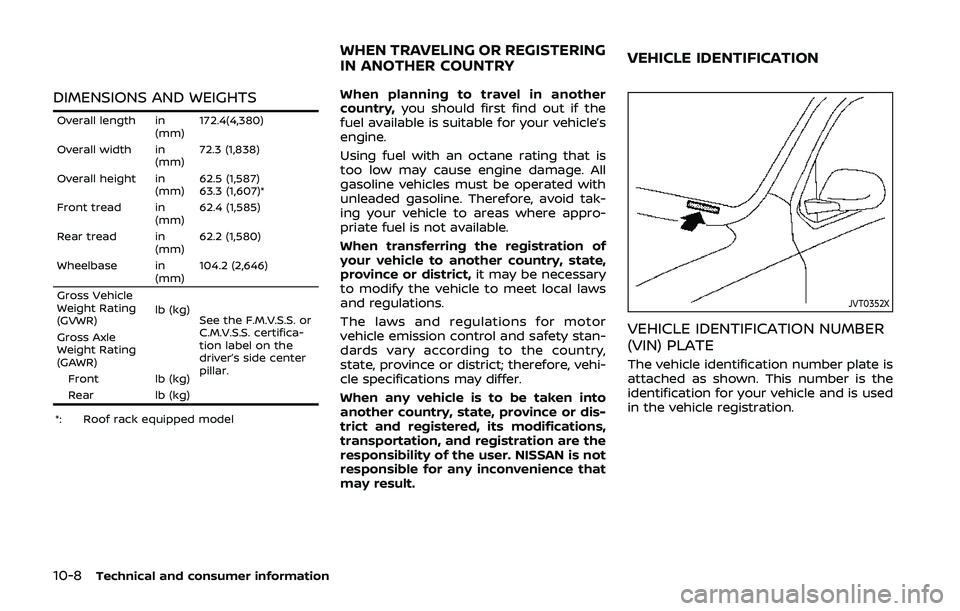
10-8Technical and consumer information
DIMENSIONS AND WEIGHTS
Overall length in(mm)172.4(4,380)
Overall width in (mm)72.3 (1,838)
Overall height in (mm)62.5 (1,587)
63.3 (1,607)*
Front tread in (mm)62.4 (1,585)
Rear tread in (mm)62.2 (1,580)
Wheelbase in (mm)104.2 (2,646)
Gross Vehicle
Weight Rating
(GVWR) lb (kg)
See the F.M.V.S.S. or
C.M.V.S.S. certifica-
tion label on the
driver’s side center
pillar.
Gross Axle
Weight Rating
(GAWR)
Front lb (kg)
Rear lb (kg)
*: Roof rack equipped model
When planning to travel in another
country, you should first find out if the
fuel available is suitable for your vehicle’s
engine.
Using fuel with an octane rating that is
too low may cause engine damage. All
gasoline vehicles must be operated with
unleaded gasoline. Therefore, avoid tak-
ing your vehicle to areas where appro-
priate fuel is not available.
When transferring the registration of
your vehicle to another country, state,
province or district, it may be necessary
to modify the vehicle to meet local laws
and regulations.
The laws and regulations for motor
vehicle emission control and safety stan-
dards vary according to the country,
state, province or district; therefore, vehi-
cle specifications may differ.
When any vehicle is to be taken into
another country, state, province or dis-
trict and registered, its modifications,
transportation, and registration are the
responsibility of the user. NISSAN is not
responsible for any inconvenience that
may result.
JVT0352X
VEHICLE IDENTIFICATION NUMBER
(VIN) PLATE
The vehicle identification number plate is
attached as shown. This number is the
identification for your vehicle and is used
in the vehicle registration.
WHEN TRAVELING OR REGISTERING
IN ANOTHER COUNTRYVEHICLE IDENTIFICATION
Page 495 of 500
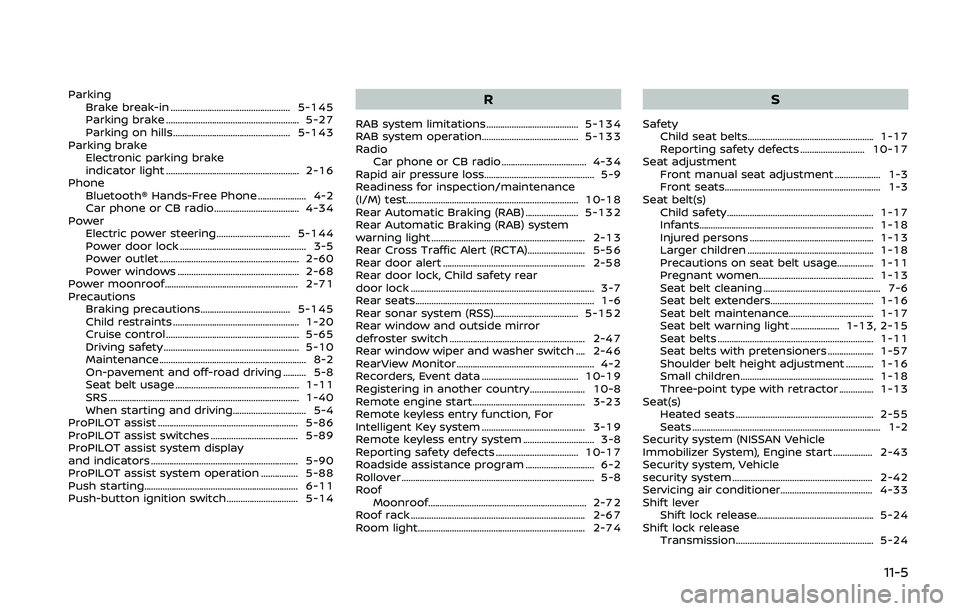
ParkingBrake break-in .................................................... 5-145
Parking brake .......................................................... 5-27
Parking on hills................................................... 5-143
Parking brake Electronic parking brake
indicator light .......................................................... 2-16
Phone Bluetooth® Hands-Free Phone ..................... 4-2
Car phone or CB radio ..................................... 4-34
Power Electric power steering................................ 5-144
Power door lock ....................................................... 3-5
Power outlet ............................................................. 2-60
Power windows ..................................................... 2-68
Power moonroof.......................................................... 2-71
Precautions Braking precautions....................................... 5-145
Child restraints ....................................................... 1-20
Cruise control .......................................................... 5-65
Driving safety ........................................................... 5-10
Maintenance................................................................ 8-2
On-pavement and off-road driving .......... 5-8
Seat belt usage ...................................................... 1-11
SRS ........................................................................\
........... 1-40
When starting and driving................................ 5-4
ProPILOT assist ............................................................. 5-86
ProPILOT assist switches ...................................... 5-89
ProPILOT assist system display
and indicators ................................................................ 5-90
ProPILOT assist system operation ................ 5-88
Push starting................................................................\
... 6-11
Push-button ignition switch............................... 5-14R
RAB system limitations ........................................ 5-134
RAB system operation.......................................... 5-133
Radio Car phone or CB radio ..................................... 4-34
Rapid air pressure loss................................................ 5-9
Readiness for inspection/maintenance
(I/M) test........................................................................\
... 10-18
Rear Automatic Braking (RAB) ....................... 5-132
Rear Automatic Braking (RAB) system
warning light ................................................................... 2-13
Rear Cross Traffic Alert (RCTA)......................... 5-56
Rear door alert .............................................................. 2-58
Rear door lock, Child safety rear
door lock ........................................................................\
........ 3-7
Rear seats........................................................................\
...... 1-6
Rear sonar system (RSS)..................................... 5-152
Rear window and outside mirror
defroster switch ........................................................... 2-47
Rear window wiper and washer switch .... 2-46
RearView Monitor............................................................ 4-2
Recorders, Event data .......................................... 10-19
Registering in another country........................ 10-8
Remote engine start................................................. 3-23
Remote keyless entry function, For
Intelligent Key system ............................................. 3-19
Remote keyless entry system ............................... 3-8
Reporting safety defects .................................... 10-17
Roadside assistance program .............................. 6-2
Rollover ........................................................................\
............ 5-8
Roof Moonroof..................................................................... 2-72
Roof rack ........................................................................\
.... 2-67
Room light........................................................................\
. 2-74
S
Safety
Child seat belts....................................................... 1-17
Reporting safety defects ............................ 10-17
Seat adjustment Front manual seat adjustment .................... 1-3
Front seats.................................................................... 1-3
Seat belt(s) Child safety................................................................ 1-17
Infants.................................................................\
........... 1-18
Injured persons ...................................................... 1-13
Larger children ....................................................... 1-18
Precautions on seat belt usage................ 1-11
Pregnant women.................................................. 1-13
Seat belt cleaning ................................................... 7-6
Seat belt extenders............................................. 1-16
Seat belt maintenance..................................... 1-17
Seat belt warning light ..................... 1-13, 2-15
Seat belts .................................................................... 1-11
Seat belts with pretensioners .................... 1-57
Shoulder belt height adjustment ............ 1-16
Small children .......................................................... 1-18
Three-point type with retractor ............... 1-13
Seat(s) Heated seats ............................................................ 2-55
Seats ........................................................................\
.......... 1-2
Security system (NISSAN Vehicle
Immobilizer System), Engine start ................. 2-43
Security system, Vehicle
security system ............................................................. 2-42
Servicing air conditioner........................................ 4-33
Shift lever Shift lock release................................................... 5-24
Shift lock release Transmission............................................................ 5-24
11-5